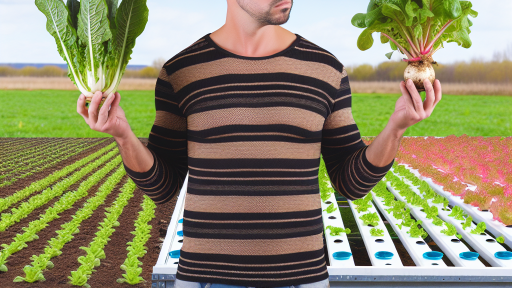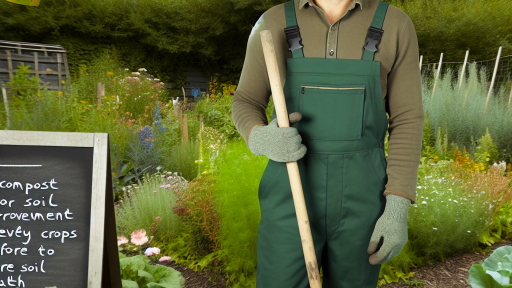Understanding Organic Gardening: Principles and Benefits
Core Principles of Organic Gardening
Organic gardening emphasizes natural processes over synthetic inputs.
It prioritizes soil health as the foundation of productive cultivation.
Moreover, it fosters biodiversity, which aids ecosystem resilience.
To achieve this, organic gardeners often use crop rotation and companion planting.
Additionally, they rely on organic fertilizers and pest management techniques.
Environmental Benefits
Organic gardening significantly enhances soil health over time.
This approach reduces pollution from synthetic chemicals.
Also, it supports local wildlife habitats, promoting biodiversity.
Furthermore, organic methods contribute to better water quality.
It minimizes runoff and protects groundwater from harmful substances.
Health Advantages
Growing organic vegetables and fruits enhances your diet quality.
These foods contain fewer pesticides and more nutrients.
Moreover, organic practices support the reduction of foodborne illnesses.
They also promote a healthier lifestyle by encouraging physical activity.
Economic Aspects
Organic gardening can lead to cost savings in the long run.
Transform Your Agribusiness
Unlock your farm's potential with expert advice tailored to your needs. Get actionable steps that drive real results.
Get StartedIt encourages self-sufficiency by reducing food expenses.
Additionally, local organic produce can fetch higher market prices.
This choice fosters community engagement and supports local farmers.
Moreover, organic operations may benefit from government grants and subsidies.
Social Impact
Organic gardening supports community and social well-being.
It creates opportunities for education through workshops and community gardens.
Such initiatives unite people around sustainable practices.
Furthermore, they promote awareness of healthy eating habits.
In essence, organic gardening can stimulate positive social change.
Selecting the Right Plants for Urban Environments
Understanding Your Urban Space
Assess the sunlight available in your space.
Consider the amount of shade and the times of day.
Evaluate your soil quality to determine what you can grow.
Think about climate conditions specific to your urban area.
Identify any space restrictions, such as size or weight limitations.
Choosing Suitable Plants
Select plants that thrive in limited space.
Opt for dwarf varieties of your favorite fruits and vegetables.
Consider container gardening for mobility and flexibility.
Look for native plants that adapt well to urban environments.
Incorporate pollinator-friendly plants to attract beneficial insects.
Incorporating Vertical Gardening
Utilize vertical space to maximize your growing area.
Install wall planters or trellises for climbing plants.
Choose compact plants that work well in small pots.
Vertical gardens improve air quality and aesthetics.
They can also enhance privacy in crowded settings.
Showcase Your Farming Business
Publish your professional farming services profile on our blog for a one-time fee of $200 and reach a dedicated audience of farmers and agribusiness owners.
Publish Your ProfileSeasonal Plant Selection
Choose plants based on seasonal changes.
For spring, consider cool-weather crops like lettuce.
In summer, plant heat-tolerant vegetables like tomatoes.
In fall, integrate crops that thrive in cooler temperatures.
Consider overwintering options for year-round gardening.
Maintaining Plant Health
Regularly check for pests that target your plants.
Implement organic pest control methods to minimize harm.
Ensure adequate watering, as urban sites can dry out more quickly.
Utilize mulching to retain moisture and regulate temperature.
Consider rotating crops to improve soil health each season.
Soil Health: How to Amend Your Soil Organically
Understanding Soil Composition
Soil consists of minerals, organic matter, air, and water.
Each component plays a vital role in plant growth.
A well-balanced soil improves nutrient availability.
Understanding your soil’s composition helps you amend it effectively.
Testing Your Soil
Testing your soil is essential before making amendments.
Purchase a soil test kit from a local garden center.
Follow the instructions carefully for accurate results.
This will provide information on pH levels and nutrient content.
Based on the results, you can determine the necessary amendments.
Organic Matter Additions
Adding organic matter enhances soil structure and fertility.
Compost is an excellent option for enriching soil.
Use well-rotted manure to boost nutrient levels.
Mulch also retains moisture and suppresses weeds.
Regularly incorporate organic materials to feed soil organisms.
Using Cover Crops
Cover crops offer numerous benefits for urban gardeners.
They protect soil from erosion and nutrient depletion.
Plant legumes to fix nitrogen levels in the soil.
Examples include clover and vetch.
After harvesting, till cover crops into the soil to improve organic matter.
Natural Soil Amendments
Several natural materials can amend your soil effectively.
- Bone meal adds phosphorus for root development.
- Wood ash provides potassium and raises pH levels.
- Green sand offers potassium and micronutrients.
- Gypsum improves soil structure, especially in clay soils.
Always apply these amendments according to your soil test results.
Maintaining Soil Health
Maintaining soil health requires ongoing care and observation.
Rotate crops each season to prevent nutrient depletion.
Monitor moisture levels to avoid compaction and erosion.
Encourage beneficial organisms by avoiding chemical pesticides.
Regularly amend your soil to keep it vibrant and productive.
Find Out More: Pollinator-Friendly Edible Landscapes
Composting in Small Spaces: Tips for Urban Gardeners
Understanding Composting
Composting transforms organic waste into valuable nutrient-rich soil.
This process reduces waste in landfills while enriching urban gardens.
Moreover, compost provides essential nutrients for plants.
Showcase Your Farming Business
Publish your professional farming services profile on our blog for a one-time fee of $200 and reach a dedicated audience of farmers and agribusiness owners.
Publish Your ProfileChoosing the Right Compost Bin
Selecting the right compost bin is crucial for urban gardeners.
Consider size and material to ensure it fits your space.
For small patios, a countertop compost bin may be ideal.
Alternatively, use a tumbling compost bin for ease of use.
What to Compost
Not everything is suitable for composting in small spaces.
Focus on kitchen scraps and yard waste for efficient composting.
- Vegetable peels and fruit scraps work well.
- Coffee grounds add nitrogen to the mix.
- Eggshells contribute calcium and improve soil health.
- Shredded paper can balance carbon levels.
Maintaining a Healthy Compost
Regular maintenance is essential for successful composting.
Keep your compost aerated by turning it frequently.
Moisture levels should be monitored carefully.
Too much moisture can lead to odors, while too little slows decomposition.
Common Challenges
Urban gardeners may face unique challenges in composting.
Pests can become a concern, but you can mitigate this.
Store your compost bin in a shaded area to deter them.
Additionally, avoid adding meats or dairy to prevent unwanted visitors.
Benefits of Composting in Urban Areas
Composting offers numerous benefits for city dwellers.
It reduces waste and promotes a sustainable lifestyle.
Furthermore, composting connects gardeners with their environment.
This practice helps nurture a vibrant urban garden ecosystem.
See Related Content: Sustainable Water Practices for Heritage Gardens
Water Conservation Techniques for Urban Gardens
Utilizing Rainwater Harvesting
Rainwater harvesting collects runoff from rooftops.
This method reduces reliance on municipal water systems.
Installing a rain barrel is a practical starting point.
Rain barrels are easy to set up and maintain.
Furthermore, this technique utilizes a natural resource effectively.
Implementing Drip Irrigation
Drip irrigation delivers water directly to plant roots.
This method minimizes evaporation and runoff.
It results in improved water efficiency for gardens.
Additionally, it reduces the frequency of watering.
Focused watering ensures plants receive adequate moisture.
Selecting Drought-Resistant Plants
Drought-resistant plants thrive in low-water conditions.
These plants require minimal irrigation once established.
Examples include succulents and native species.
Choosing native plants supports local ecosystems.
Ultimately, this choice enhances garden resilience.
Mulching for Moisture Retention
Mulching helps retain soil moisture and suppress weeds.
Organic materials like straw or wood chips work best.
Apply a layer of mulch around plants for maximum effect.
This practice reduces the need for frequent watering.
Additionally, it improves soil temperature and health.
Creating a Water-Wise Garden Layout
Garden layout impacts water use significantly.
Showcase Your Farming Business
Publish your professional farming services profile on our blog for a one-time fee of $200 and reach a dedicated audience of farmers and agribusiness owners.
Publish Your ProfileGrouping plants with similar water requirements is essential.
This method reduces water waste and promotes efficiency.
Consider placing drought-tolerant plants in sunny areas.
In shaded spots, plant species that require more moisture.
See Related Content: Companion Planting with Heirloom Crops
Natural Pest Management: Organic Solutions to Common Pests
Understanding Common Pests
Urban gardens can attract a variety of pests.
Understanding these pests is vital for effective management.
Common pests include aphids, spider mites, and whiteflies.
Each pest has unique characteristics and behaviors.
Preventive Measures
Start with preventive measures to reduce pest problems.
Healthy plants are less susceptible to pests.
Provide proper spacing for air circulation and sunlight.
Use organic soil amendments to boost soil health.
Encourage beneficial insects that prey on pests.
Organic Pest Control Methods
When pests do appear, various organic methods exist.
Handpicking can be effective for larger pests.
Use insecticidal soap to target soft-bodied insects.
Introduce biological control agents like ladybugs.
Neem oil is another effective solution for many pests.
Creating a Pest-Resistant Garden
Select pest-resistant plant varieties to minimize infestations.
Companion planting can deter unwanted insects.
Certain herbs, such as basil and marigold, repel pests.
Consider crop rotation to disrupt pest life cycles.
Monitoring and Maintenance
Regularly inspect plants for signs of pests.
Early detection is key to managing infestations.
Keep detailed records of pest populations and control efforts.
Adjust your strategies based on what works best in your garden.
Explore Further: Seed Saving Methods for Heritage Plants

Utilizing Vertical and Container Gardening Methods
Maximizing Small Spaces
Vertical gardening makes the most of limited urban spaces.
Using wall-mounted planters can save floor space effectively.
Consider trellises to support climbing plants like tomatoes and cucumbers.
These structures can add visual interest to your garden.
Choosing the Right Containers
Select containers suitable for your available space.
Options include pots, barrels, and hanging planters.
Ensure containers have proper drainage to support plant health.
Use lightweight materials for easy mobility, such as resin or plastic.
Effective Soil and Fertilization
Choose organic potting mix for optimal growth in containers.
A blend of compost, peat moss, and vermiculite offers nutrients.
Regularly check soil moisture to maintain healthy plants.
Consider using organic fertilizers for an eco-friendly approach.
Showcase Your Farming Business
Publish your professional farming services profile on our blog for a one-time fee of $200 and reach a dedicated audience of farmers and agribusiness owners.
Publish Your ProfilePlant Selection for Containers
Opt for plants that thrive in confined spaces.
Herbs like basil and cilantro are ideal for containers.
Vegetables such as peppers and small squash perform well too.
Choose dwarf or compact varieties for limited room gardens.
Watering Techniques
Implement a consistent watering schedule for container plants.
Check the soil moisture level regularly to avoid overwatering.
Use drip irrigation to ensure plants receive adequate hydration.
Consider self-watering containers to simplify maintenance.
Pest Management Strategies
Monitor your plants regularly for signs of pests.
Introduce beneficial insects like ladybugs to manage aphids.
Use neem oil or insecticidal soap as organic pest control options.
Encouraging biodiversity helps create a balanced ecosystem.
Seasonal Adjustments and Rotation
Plan crop rotations to maintain soil health in containers.
Switch plants based on seasonal availability for better yields.
Adjust care techniques according to the changing weather conditions.
This flexibility maximizes growth potential throughout the year.
Creating a Pollinator-Friendly Urban Garden
Understanding the Importance of Pollinators
Pollinators play a vital role in our ecosystem.
They help in the reproduction of many plants.
Additionally, they contribute to food production in urban areas.
A diverse array of species benefits urban gardens greatly.
Choosing the Right Plants
Select native plants to attract local pollinators.
Consider flowers that bloom at different times of the year.
This ensures consistent food sources throughout the seasons.
Daisy, echinacea, and milkweed are excellent options.
Creating Habitat for Pollinators
Provide nesting spaces to support pollinator populations.
Incorporate features such as bee hotels and brush piles.
These habitats foster a welcoming environment.
Ensure to avoid using chemical pesticides in your garden.
Providing Water Sources
Pollinators need water to thrive in urban gardens.
Create shallow dishes filled with pebbles and water.
This allows for safe access to hydration.
Remember to refresh the water regularly.
Encouraging Community Involvement
Engage neighbors to participate in pollinator-friendly practices.
Organize community planting events to promote awareness.
This can strengthen community bonds and increase biodiversity.
Sharing information on benefits leads to greater support.
Seasonal Planting and Crop Rotation Strategies for Urban Spaces
Understanding Seasonal Planting
Seasonal planting enhances productivity in urban gardens.
Different plants thrive in specific seasons.
Consider planting cool-season crops in early spring.
Examples include lettuce, peas, and radishes.
Showcase Your Farming Business
Publish your professional farming services profile on our blog for a one-time fee of $200 and reach a dedicated audience of farmers and agribusiness owners.
Publish Your ProfileWarm-season crops perform best after the last frost.
Examples include tomatoes, peppers, and cucumbers.
Monitor local frost dates to plan effectively.
Timing Your Planting
Start with a planting calendar tailored to your region.
Research the unique climate conditions in your city.
Adjust your planting schedule based on the weather forecasts.
Pay attention to soil temperature for seed germination.
Utilize row covers to protect tender plants from cold snaps.
Importance of Crop Rotation
Crop rotation prevents soil depletion and disease buildup.
Each plant family offers distinct nutrient requirements.
Rotating crops helps maintain soil fertility.
Furthermore, it disrupts pest and pathogen life cycles.
Implementing Crop Rotation Strategies
Plan your garden layout with future plantings in mind.
Group plants by family to streamline your rotation.
For instance, follow legumes with leafy greens.
Employ a three-to-four-year rotation if possible.
This strategy creates a balanced environment for soil health.
Utilizing Companion Planting
Companion planting enhances growth and deters pests.
Some plants benefit nearby species significantly.
For example, marigolds repel nematodes and other insects.
Pairing garlic with roses improves their resilience.
Experimenting with Vertical Gardening
In urban spaces, vertical gardens maximize limited areas.
Utilize trellises to support climbing plants.
Find opportunities to grow vertically using containers.
This approach increases your planting surface.
Continuous Learning and Adaptation
Stay updated on the latest urban gardening strategies.
Join local gardening clubs or online communities.
Share experiences with fellow urban gardeners.
Attend workshops to enhance your skills continuously.




